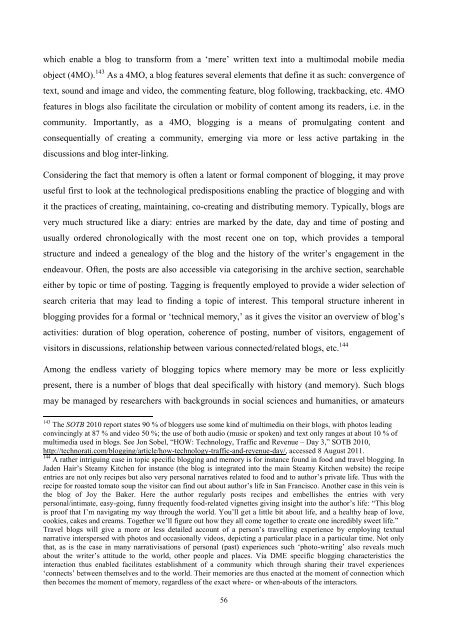UNIVERSITY OF NOVA GORICA GRADUATE SCHOOL ...
UNIVERSITY OF NOVA GORICA GRADUATE SCHOOL ...
UNIVERSITY OF NOVA GORICA GRADUATE SCHOOL ...
Create successful ePaper yourself
Turn your PDF publications into a flip-book with our unique Google optimized e-Paper software.
which enable a blog to transform from a ‗mere‘ written text into a multimodal mobile media<br />
object (4MO). 143 As a 4MO, a blog features several elements that define it as such: convergence of<br />
text, sound and image and video, the commenting feature, blog following, trackbacking, etc. 4MO<br />
features in blogs also facilitate the circulation or mobility of content among its readers, i.e. in the<br />
community. Importantly, as a 4MO, blogging is a means of promulgating content and<br />
consequentially of creating a community, emerging via more or less active partaking in the<br />
discussions and blog inter-linking.<br />
Considering the fact that memory is often a latent or formal component of blogging, it may prove<br />
useful first to look at the technological predispositions enabling the practice of blogging and with<br />
it the practices of creating, maintaining, co-creating and distributing memory. Typically, blogs are<br />
very much structured like a diary: entries are marked by the date, day and time of posting and<br />
usually ordered chronologically with the most recent one on top, which provides a temporal<br />
structure and indeed a genealogy of the blog and the history of the writer‘s engagement in the<br />
endeavour. Often, the posts are also accessible via categorising in the archive section, searchable<br />
either by topic or time of posting. Tagging is frequently employed to provide a wider selection of<br />
search criteria that may lead to finding a topic of interest. This temporal structure inherent in<br />
blogging provides for a formal or ‗technical memory,‘ as it gives the visitor an overview of blog‘s<br />
activities: duration of blog operation, coherence of posting, number of visitors, engagement of<br />
visitors in discussions, relationship between various connected/related blogs, etc. 144<br />
Among the endless variety of blogging topics where memory may be more or less explicitly<br />
present, there is a number of blogs that deal specifically with history (and memory). Such blogs<br />
may be managed by researchers with backgrounds in social sciences and humanities, or amateurs<br />
143 The SOTB 2010 report states 90 % of bloggers use some kind of multimedia on their blogs, with photos leading<br />
convincingly at 87 % and video 50 %; the use of both audio (music or spoken) and text only ranges at about 10 % of<br />
multimedia used in blogs. See Jon Sobel, ―HOW: Technology, Traffic and Revenue – Day 3,‖ SOTB 2010,<br />
http://technorati.com/blogging/article/how-technology-traffic-and-revenue-day/, accessed 8 August 2011.<br />
144 A rather intriguing case in topic specific blogging and memory is for instance found in food and travel blogging. In<br />
Jaden Hair‘s Steamy Kitchen for instance (the blog is integrated into the main Steamy Kitchen website) the recipe<br />
entries are not only recipes but also very personal narratives related to food and to author‘s private life. Thus with the<br />
recipe for roasted tomato soup the visitor can find out about author‘s life in San Francisco. Another case in this vein is<br />
the blog of Joy the Baker. Here the author regularly posts recipes and embellishes the entries with very<br />
personal/intimate, easy-going, funny frequently food-related vignettes giving insight into the author‘s life: ―This blog<br />
is proof that I‘m navigating my way through the world. You‘ll get a little bit about life, and a healthy heap of love,<br />
cookies, cakes and creams. Together we‘ll figure out how they all come together to create one incredibly sweet life.‖<br />
Travel blogs will give a more or less detailed account of a person‘s travelling experience by employing textual<br />
narrative interspersed with photos and occasionally videos, depicting a particular place in a particular time. Not only<br />
that, as is the case in many narrativisations of personal (past) experiences such ‗photo-writing‘ also reveals much<br />
about the writer‘s attitude to the world, other people and places. Via DME specific blogging characteristics the<br />
interaction thus enabled facilitates establishment of a community which through sharing their travel experiences<br />
‗connects‘ between themselves and to the world. Their memories are thus enacted at the moment of connection which<br />
then becomes the moment of memory, regardless of the exact where- or when-abouts of the interactors.<br />
56

















